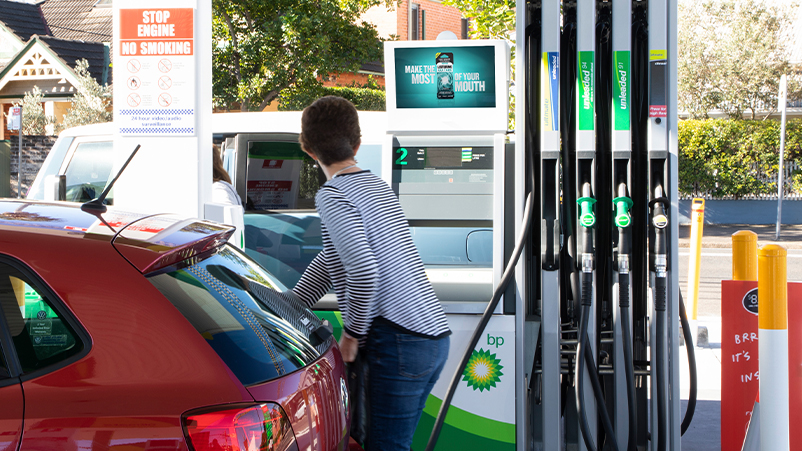Covid-resistant advertising: Petro and convenience OOH locations fill brand tanks and baskets through lockdowns

While some OOH audiences have collapsed 64 per cent, petrol stations and convenience stores are up 6 per cent – making them essential services for advertisers as well as shoppers now returning day-in, day out.
Out of home advertising is always going to suffer when lockdowns bite. But while some OOH audiences have collapsed 64 per cent, petrol stations and convenience stores are up 6 per cent – making them essential services for advertisers as well as shoppers now returning day-in, day out.
As Sydneysiders trudge through an extended lockdown, our neighbours below in Melbourne continue to snap in and out of lockdown faster than Emma McKeon racked up seven medals at Tokyo 2020. Meanwhile, our mates above in South-east Queensland who have remained mostly unscathed by Covid recently had their own experience of lockdown life. Life over the past 18 months has been a cycle of restrictions, closures, lockdowns, rinse and repeat. Apart from essential workers and essential stores, nobody and no place has been unaffected by the pandemic.
The general out-of-home advertising landscape, though holding its own, hasn’t been immune to this disruption. But one unassuming yet critical OOH destination that’s performed throughout this tumultuous period, is advertising based in petro and convenience locations.
With the limitations set on long-distance driving in certain areas, you'd think Aussies wouldn’t be frequenting petrol stations as often. However petro locations have become much more than just a place to fill-up the tank.
On-the-go advertising locations are Covid-resistant
Covid-19 continues to be an unparalleled disruptor creating nervousness and caution in the ad market. However, real-time DART findings by VMO continually prove that across VMO On-the-go locations, audiences remained steady despite fluctuating restrictions, closures and lockdowns.
VMO managing director Paul Butler says, “The VMO on-the-go environment has proven its might, cementing itself as an invaluable essential destination for Australian consumers. DART real-time insights show audiences in H1 2021 up 6.0 per cent on baseline average^, with consumers leaning heavily on on-the-go locations for everyday essential purchases.
“Routines may have changed, but these findings highlight that petro and convenience locations have become essential service destinations and part of our new hyper-localised every day. The steadiness of the on-the-go environment is emphasised in comparison to other traditional OOH and place-based media. For example, some out-of-home sectors have seen audience declines of up to 64 per cent, while VMO on-the-go has been steady in the face of the pandemic”.
The C-store renaissance
Driving this is the evolution of the petro convenience store. It’s no longer about filling up the tank and grabbing a chocolate bar on your way out. There’s a real renaissance in the significance of convenience to consumers, as people gravitate towards services that compliment, rather than complicate their busy lifestyle.
As Danielle Cameron, General Manager Commercial Partnerships at VMO says, “The petrol station during normal times is the ‘last mile’ before going home. But it’s now part of our local community and many tasks can be completed with one stop, and within proximity to home.”
Recent findings from the Australasian Association of Convenience Stores (AACS) comparing 2019 to 2020 shows the Convenience Channel (Shop) grew by 5.1 per cent year-on-year to $9.22 billion in sales, versus the previous year of $8.7 billion. Meanwhile, research conducted early into the pandemic compiled by CMA for AACS shows the petrol and convenience sector was voted the most trusted retail sector to shop in during the lockdown measures, with 51 per cent of those surveyed saying they felt ‘totally comfortable’ in C-stores.
Not to mention C-store sites are physically transforming into premium service destinations, and not the dingy and bare-basic stores many of us grew up with. Through offering fresh produce, premium services, cafes and ultimately more choice to consumers, C-stores are becoming increasingly desirable. This is especially true for consumers who are looking to avoid the crowds at major grocery outlets in favour of something smaller, less crowded and closer to home.
“There are now over 7,000 petrol and convenience locations across Australia – one of the few bricks and mortar businesses continuing to grow,” says Cameron.
“Barista-made coffee changed the sector, making it an appointment stop with consumers who could now get quality coffee, conveniently and quickly. Now with multiple products and services in one spot, convenience retail continues to grow. C-stores have become supermarkets in their own right.”
Cutting through with distraction-free advertising
The question then becomes what value are advertisers seeing in VMO’s on-the-go locations?“There are several points of difference that make this advertising medium such a unique asset,” he continues. “Firstly, there’s the scale. With over 600 locations, 3,500 screens and up to five million unique Aussies visiting our locations every two weeks. This audience is captive, free of distractions for up to four minutes while they fill up. Finally, on-the-go advertising captures the attention of Aussies entering the convenience store – the final point of influence on path-to-purchase.”
^Source: DART proprietary audience measurement: 17th January – 3rd June vs baseline weekly norm average levels (17th January - 29th March 2020)
*Source: VMO independent research, Data2Decisions June 2018
